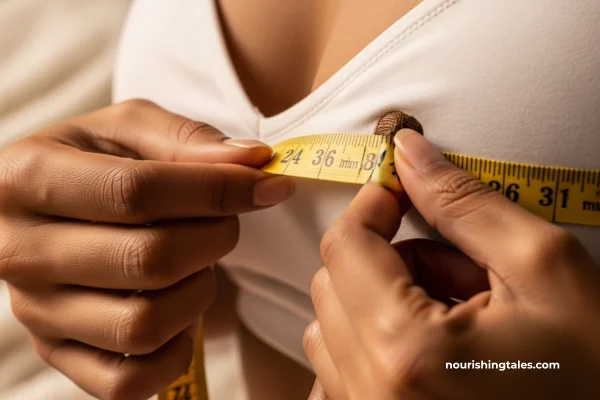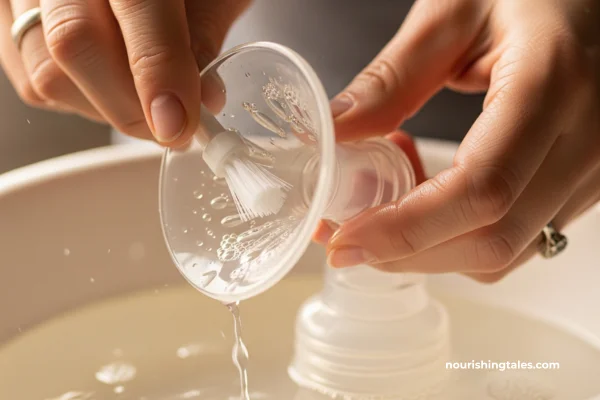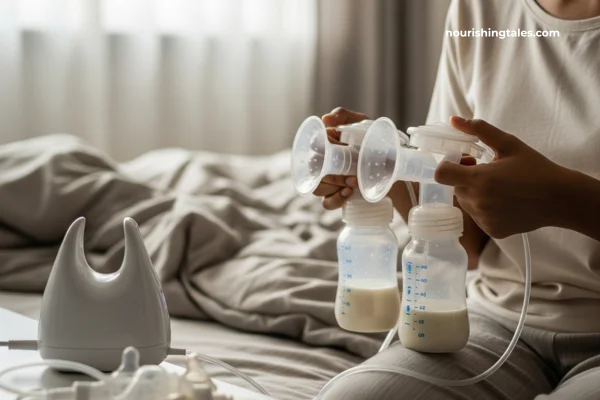Your first pumping session starts here, with the breast pump out of the box, sitting on the table. With all its tubes and parts, it can look a little intimidating, and it’s completely normal to feel a bit overwhelmed. You are not alone in this feeling.
Before we go any further, I want you to let go of any pressure you might be feeling. Forget any expectations about how much milk you “should” get. Today is not about ounces or millilitres. Today is about one simple thing: getting to know your pump.
Let’s walk through this together, one gentle step at a time. I’ll be right here with you.
Part 1: Your 5-Minute Prep for a Calm Session
Before you even turn the pump on, let’s create a little pocket of calm for you. This will only take a few minutes, but it makes a world of difference.
- A Quick Glance at Your Manual: I know, I know—who has time for manuals? But just take two minutes to look at the diagram of your specific pump. This will help you get familiar with the main parts. No memorisation needed, just a quick hello.
- Wash and Assemble Your Parts: For this first session, all the parts that will touch your precious milk need to be washed and sterilised. This is crucial for your baby’s safety. Once they’re dry, assemble one or two bottles for your session. If you need a quick refresher, we have a complete guide on how to clean your pump parts to make it easy.
- Find Your Cosy Spot: Where will you be pumping? Find a comfortable chair where you can lean back and let your shoulders drop. Grab a big glass of water and maybe a healthy snack. You’re doing important work, and you need fuel!
- Wash Your Hands: A simple but vital step. Wash your hands thoroughly with soap and warm water.
- Take One Calming Breath: This might be the most important step of all. Close your eyes. Take a slow, deep breath in through your nose, and let it all out through your mouth. Feel your shoulders drop away from your ears. Let go of the nervousness. You are simply learning something new. You are doing an amazing job.
Okay. Let’s begin.
Part 2: The Main Event: Let’s Start Pumping!
Here we go. We’re going to do this step-by-step. There’s no rush at all.
Step 1: Get Comfortable Settle back into your calm spot. Pop a pillow behind your back. Lean back slightly, unclench your jaw, and just relax. The more relaxed you are, the more easily your milk will flow.
Step 2: Centre the Flange Gently place the flange (the cone-shaped part) over your breast. You want your nipple to be perfectly centred in the tunnel, not touching the sides. It should form a comfortable, airtight seal. If it pinches or feels uncomfortable, gently break the seal with your finger and try again.
A quick note: Proper flange fit is the key to comfortable and effective pumping. If you’re unsure, our handy flange sizing guide can help you find your perfect fit.
Step 3: Turn the Pump On (Low and Slow!) Find the power button and turn it on. Now, make sure it’s on the absolute lowest setting. We are aiming for gentle stimulation, not strong suction. We can always increase it later.
Step 4: Start in “Let-Down” Mode Most electric pumps will start in a special mode designed to mimic a baby’s initial quick, fluttery sucks. This might be called “Stimulation,” “Massage,” or “Let-down” mode. It sends a gentle signal to your body that it’s time for milk. Let the pump stay in this mode for about two minutes.
Step 5: Switch to “Expression” Mode After a couple of minutes, or once you see milk beginning to drip or spray more steadily, it’s time to switch modes. Press the button to change to “Expression” mode. You’ll notice the suction pattern becomes slower, deeper, and more rhythmic.
Step 6: Find Your Comfort Setting Now, you can slowly increase the suction level, one notch at a time. Stop when you feel a gentle, comfortable pull. Pumping should never, ever hurt. If you feel any pinching or pain, turn the suction down immediately. Remember, pumping shouldn’t hurt, and if it does, it’s a sign that something needs adjusting.
Step 7: Relax for 15 Minutes Set a timer for 15 minutes. Now, here’s a little secret: try not to watch the bottles. Staring at them can create stress, which can actually hinder your milk flow. Instead, cover the bottles with a nursing cloth or a baby blanket.
Look at a photo or video of your baby. Smell a piece of their clothing. Close your eyes and think about holding them close. This connection helps your body release oxytocin, the “love hormone” that allows your milk to flow freely.
Step 8: Gently Finish Up When your timer goes off, you’re done! First, turn the pump off completely. The suction will release. Then, to remove the flanges, gently slide a clean finger between your breast and the flange to break the seal. They will come away easily. You did it!
Part 3: After Your Session
You’ve completed your very first pumping session. High five! Here’s what to do next.
- Care for Your Liquid Gold: Look in the bottles. You may only have a few drops or a few millilitres. Please hear me when I say this: that is a huge success. That is precious colostrum or early milk, packed with antibodies and nutrients for your baby. Carefully seal the bottles and put them straight into the fridge. To learn exactly how long it can be stored, check out our simple guide to storing breast milk safely.
- Rinse Your Parts: Take your pump parts to the sink and give them a good rinse with cool water to get the milk off. You can wash them properly later when you have more time.
A Few Gentle Reminders: “Is This Normal?”
It’s so easy to second-guess yourself. Let’s talk through what you might be thinking right now.
“I barely got any milk! Did I do something wrong?” No, my dear, you did it perfectly. The goal of this first session was not to fill a bottle; it was to introduce your body to the pump and send the “order” for more milk. Stimulation is the real victory here. Those first few drops are a wonderful bonus.
“It felt a bit strange.” Of course, it did! It’s a completely new sensation. It’s not the same as your baby nursing, and it can take a few sessions to get used to the feeling. As long as it wasn’t painful, “a little weird” is completely normal.
“One of my breasts produced more than the other.” This is incredibly common! Most women have one breast that is the “star player” and one that’s the “supporting artist.” Don’t worry about them being perfectly even. It’s a team effort.
You Are Doing an Amazing Job
Take one more deep breath and feel proud of yourself. You faced something new, you were patient, and you successfully completed your very first pumping session. That is a massive achievement.
This journey is a marathon, not a sprint, and you just took the most important first step. Be gentle with yourself. Be patient with your body. You are doing an incredible job, and you are exactly the parent your baby needs.
You’ve got this.
Disclaimer: This article is for informational purposes only and does not constitute medical advice. Please consult with a certified lactation consultant (IBCLC) or your healthcare provider for personalised advice regarding your specific situation.




